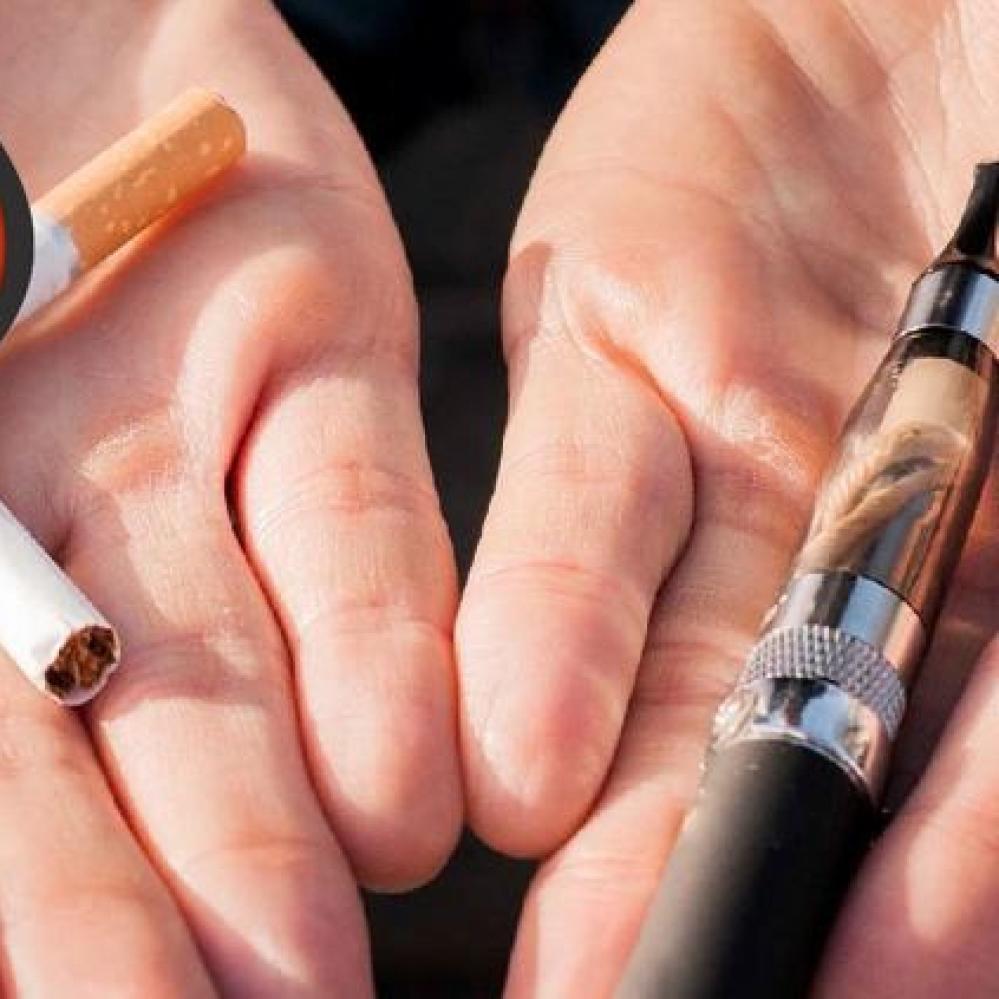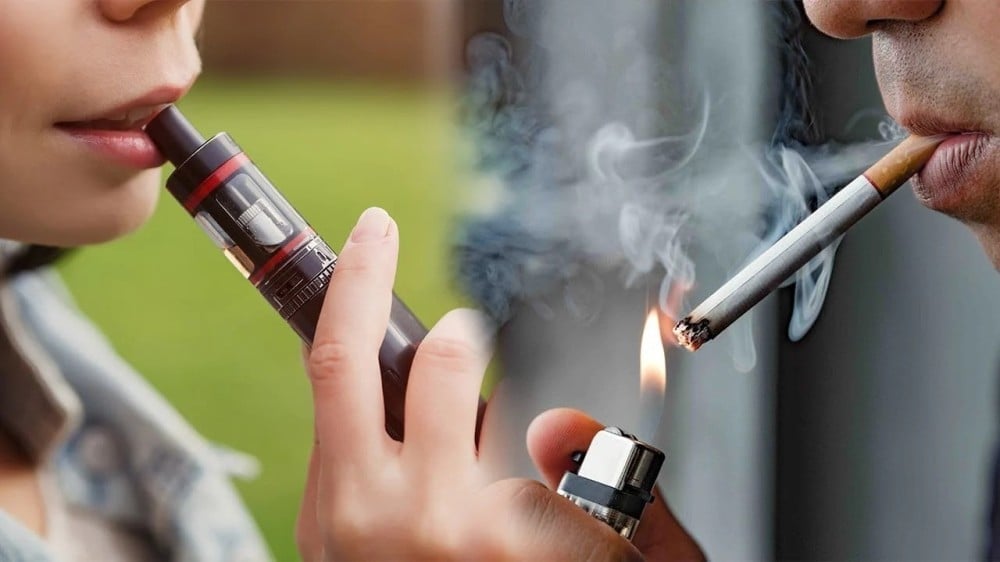

Welcome to [VAPE Saudi Arabia], your ultimate destination for exploring and understanding the world of vaping and traditional cigarettes. As more people seek alternatives to smoking, the debate intensifies: Traditional Cigarettes vs. Vaping - Understanding the Key Differences. Our comprehensive guide delves into this smoking dilemma and questions whether vaping is indeed a safer alternative to traditional cigarettes.
Health impacts are at the forefront of this conversation. We compare the risks of smoking cigarettes and vaping to offer a clearer perspective. From ash to vapor, discover how traditional smoking and vaping differ in terms of flavor, delivery, and health implications.
Breaking down the myths: in the modern era, cigarettes vs. vaping presents a complex choice—one that involves understanding nicotine and how vaping and traditional cigarettes measure up against each other. With emerging regulations and trends, the growing divide between vaping and smoking becomes evident.
A shift in habits is underway, with many choosing vaping over traditional cigarettes. But which one is right for you? Our guide dives into the science behind cigarettes and vapes, helping you make an informed decision.
Financial considerations also play a role; we explore the cost comparison: Is vaping cheaper than smoking traditional cigarettes? Evaluate the flavor and experience that vaping offers, and see how it changes the smoking game.
Social perceptions and environmental impact are additional facets to consider. Are vapes more eco-friendly than cigarettes? And in modern culture, how do cigarettes vs. vaping stand?
Finally, for those looking to quit smoking, we address a crucial question: Can vaping help you transition away from cigarettes? Let [Your Brand Name] be your trusted resource in navigating these waters, ensuring you make the best decision for your lifestyle and health.

Health Impacts: Comparing the Risks of Smoking Cigarettes and Vaping
Detrimental Effects of Cigarettes
The health risks associated with traditional smoking are profoundly documented and have been the subject of extensive research. Cigarettes release thousands of harmful chemicals, including tar, carbon monoxide, and various carcinogens that lead to devastating health issues. Common detrimental effects include:
- Respiratory Problems: Chronic bronchitis and emphysema are common ailments among smokers due to lung damage.
- Cardiovascular Disease: Smoking contributes to heart attacks and strokes by damaging blood vessels?
- Cancer Risk: Lung cancer is one of the most prominent cancers linked to smoking, but it can also lead to throat, mouth, and bladder cancers.
Moreover, secondhand smoke poses severe health risks to non-smokers, highlighting the need for a cease in tobacco use altogether.
Vaping's Elimination of Tar Production
Unlike traditional cigarettes, vaping significantly reduces the production of tar, which is the sticky substance that clings to lungs and airways. E-cigarettes work by vaporizing liquid rather than burning tobacco, which leads to the generation of aerosol. This aerosol typically contains fewer harmful substances than smoke.
For instance, studies suggest that while both vaping and smoking carry risks, the absence of combustion in vaping means users are exposed to:
- Lower Levels of Carcinogens: Vaping products have far fewer toxic substances than traditional cigarettes.
- Reduction in Respiratory Irritation: Vapers often report fewer breathing issues compared to smokers.
Long-Term Health Impacts Evaluation
Even with lower risks associated with vaping, evaluating the long-term health impacts remains crucial. Research is ongoing, but some key points include:
- Nicotine Addiction: Both vaping and smoking deliver nicotine, maintaining a dependency that affects quitting efforts.
- Potential Unknown Risks: Current research often lacks longitudinal studies, prompting caution among transitioning users.
Taking a balanced perspective is essential. While vaping may present less harmful options compared to traditional cigarettes, consumers must remain informed and cautious about its long-term health effects.
From Ash to Vapor: How Traditional Smoking and Vaping Differ
Combustion in Traditional Smoking vs. Vapor Production in Vaping
Transitioning from traditional smoking to vaping introduces users to a significant change in how they consume nicotine. Traditional cigarettes rely on combustion, a process where tobacco is ignited, producing smoke filled with harmful chemicals.
In contrast, vaping involves heating e-liquid (also known as vape juice) to create vapor without combustion. This fundamental difference leads to distinct user experiences. For example:
- Temperature: Cigarettes burn at incredibly high temperatures, releasing toxins, while vaporizers operate at lower temperatures.
- Smell: Smokers often deal with lingering odors and ash, whereas vapers can enjoy a variety of scents depending on their chosen flavors.
Chemicals in Smoke vs. Liquid Vapor
The chemical composition between smoke and vapor underscores their contrasting health impacts. Traditional cigarette smoke contains over 7,000 chemicals, many of which are toxic or carcinogenic. Some of the most notorious include:
- Tar: A sticky substance that accumulates in the lungs.
- Carbon Monoxide: A poison that impairs oxygen delivery in the body.
On the flip side, e-liquid vapor experiences a much simpler chemical profile. Ingredients typically comprise:
- Vegetable Glycerin and Propylene Glycol: Common bases for the liquid.
- Flavorings: Added to create diverse tastes.
Although vaping is not without its risks, the absence of many harmful compounds present in cigarette smoke is a notable benefit.
User Experience and Health Risks Comparison
When it comes to user experience, many people find vaping more appealing than smoking. The customizable flavor options, reduced odor, and often smoother inhalation contribute to its popularity. However, health risks remain a valid concern.
- Health Effects: While vaping reduces exposure to many harmful substances, it is not risk-free. Users may still encounter respiratory issues or nicotine addiction.
- Community and Culture: Vaping has created a unique social scene, often regarded as a non-smoker's alternative.
In conclusion, understanding these differences helps users make informed choices about their health and lifestyle.
Flavor, Delivery, and Health: What Sets Vaping Apart from Cigarette Smoking
Variety of Flavors in Vaping
One of the most significant factors that distinguish vaping from traditional smoking is the incredible variety of flavors available in e-liquids. While smokers largely have to contend with the earthy taste of tobacco, vapers can explore an extensive range of options.
From fruity and sweet flavors to rich dessert blends, the possibilities are virtually endless. For example:
- Fruity Flavors: Mango, strawberry, or watermelon provide a refreshing alternative.
- Beverage-Inspired Varieties: Coffee, cola, or energy drink flavors mimic popular drinks.
- Dessert Flavors: Indulgent profiles like cheesecake or chocolate cake cater to those with a sweet tooth.
Such diversity allows vapers to personalize their experience in ways smokers cannot.
Nicotine Delivery in Vapor Form
Another crucial aspect of vaping is nicotine delivery. Traditional cigarettes typically deliver nicotine quickly to the bloodstream through combustion smoke, creating an immediate effect. Vaping, though different, achieves similar results through aerosol.
In vaping, nicotine is absorbed into the bloodstream efficiently, providing an experience that can satisfy the cravings of nicotine users:
- Adjustable Nicotine Levels: Vapers can choose e-liquids with varying nicotine concentrations, allowing them to manage their intake more easily.
- Smoother Inhalation: Many find vapor inhalation less harsh on the throat compared to cigarette smoke.
Customizable Experience in Vaping
The customizable nature of vaping enhances user experience even further. Beyond flavors and nicotine levels, users can adjust their devices to match personal preferences:
- Device Settings: Users can modify wattage and temperature settings, affecting taste and throat hit.
- Tank and Coil Options: Different tanks and coils offer unique vapor production and flavor intensity.
This level of customization empowers users to create a personalized vaping experience that suits their lifestyle and preferences, which is significantly lacking in traditional smoking.
In summary, the flavor variety, nicotine delivery methods, and customizable experiences in vaping not only set it apart from traditional cigarettes but also provide users with options that align more closely with their desires and health goals.
Breaking Down the Myths: Cigarettes vs. Vaping in the Modern Era
Safety Misconceptions of Vaping
As vaping gained popularity, a myriad of misconceptions about its safety emerged. Many individuals mistakenly view vaping as completely risk-free, equating it to harmless activities like chewing gum. However, that belief can be misleading.
For example, reports have highlighted concerns over lung health and the potential for certain flavorings, such as diacetyl, linked to serious respiratory issues. Some people may think, "Well, it’s just vapor," underestimating the fact that vaping still introduces substances into the body.
Key myths include:
- "Vaping is Safe for Everyone": Vaping is not recommended for non-smokers or minors due to the risks of nicotine addiction.
- "All E-liquids are the Same": The quality and ingredients in e-liquids can vary significantly, impacting safety.
Informed Caution in Using Vaping Products
That said, informed caution is essential for anyone considering vaping. Users should approach vaping products with a mindset grounded in research and discernment. Here are some suggestions:
- Research Brands: Look for reputable manufacturers known for using quality ingredients.
- Check Reviews: User feedback can reveal insights into product performance and safety.
- Utilize Resources: Websites dedicated to harm reduction provide valuable information on safe vaping practices.
Understanding Benefits and Risks of Vaping
Navigating the benefits and risks of vaping is crucial for making informed decisions.
Benefits may include:
- Reduced Exposure to Harmful Chemicals: Compared to traditional cigarettes, vaping typically contains fewer toxic substances.
- Smoking Cessation Aid: For some, vaping serves as a transitional tool while quitting smoking.
Conversely, risks to consider include potential respiratory issues and the possibility of developing nicotine dependence.
By providing balanced perspectives about vaping and debunking myths with factual information, individuals can make educated choices that align with their health goals while minimizing risks. Understanding the complete picture is key to approaching vaping as a sensible alternative or a step toward cessation, rather than merely a trend.
Vaping vs. Traditional Cigarettes: Which One is Right for You?
Personal Choice Based on Health Goals and Lifestyle
When contemplating whether to vape or continue smoking traditional cigarettes, personal goals and lifestyle choices play a pivotal role. Each individual has unique health objectives, and understanding them is essential to making an informed decision. For example, someone focused on quitting smoking altogether may find vaping a suitable alternative due to its relatively lower health risks.
Consider these questions to guide your choice:
- What are your health priorities? If reducing exposure to harmful substances is crucial, vaping might be preferable.
- How important is flavor diversity to you? If you enjoy experimenting with flavors, vaping offers a wealth of options.
Vaping as a Transitional Tool for Quitting Nicotine
For many individuals, especially those who have struggled with nicotine addiction, vaping serves as an effective transitional tool for quitting. Research suggests that vaping can help ease the withdrawal symptoms experienced when quitting cigarettes.
Some potential benefits include:
- Gradual Nicotine Reduction: Vapers can gradually lower nicotine levels over time until they quit completely.
- Support System: Online communities and resources are dedicated to vaping for quitting, providing support and encouragement.
By choosing to vape as a stepping stone, individuals can tailor their journey towards a smoke-free life.
Habit and Preference Considerations
Ultimately, habit and personal preferences also shape the decision between smoking and vaping. Some smokers truly enjoy the act of smoking and the sensation of a cigarette, and they may find it challenging to transition to vaping.
Key aspects to weigh include:
- Social Context: Smoking habits may stem from social circles. Understanding how peer influence affects your choice is crucial.
- Accessibility and Cost: Evaluating the cost-effectiveness and accessibility of vaping products versus cigarettes can also impact your decision.
In conclusion, determining whether vaping or traditional cigarettes are right for you boils down to personal health goals, habits, and lifestyle factors. By weighing these considerations, individuals can make choices that resonate with their wellbeing and specific circumstances, leading to a conscientious approach to smoking and nicotine consumption.
Understanding Nicotine: How Vaping and Traditional Cigarettes Measure Up
Varying Nicotine Levels in Vaping and Traditional Cigarettes
When it comes to nicotine consumption, there's a noticeable distinction between traditional cigarettes and vaping products. Traditional cigarettes typically deliver a fixed amount of nicotine per cigarette, averaging about 12 mg per stick. However, the actual amount absorbed by the body can vary greatly depending on how deeply a smoker inhales.
In contrast, vaping allows for a broader range of nicotine levels. Many e-liquids contain anywhere from 0 mg to 50 mg of nicotine per milliliter, allowing users to select a concentration that suits their needs. This flexibility can be beneficial for those looking to reduce their nicotine intake gradually.
Control of Nicotine Concentration in E-liquids
One of the primary advantages of vaping is the ability to control the nicotine concentration in e-liquids. Vapers can choose specific strengths based on their preference or goals. For example:
- High Nicotine Levels: Suitable for those transitioning from cigarettes or seeking quick relief from cravings.
- Medium Levels: Ideal for users wanting some nicotine while enjoying flavors.
- Low to Zero Nicotine: Best for those aiming to quit or significantly reduce their intake.
This customization allows for a more personalized experience compared to traditional smoking, where nicotine levels are predetermined.
Comparing Intake Management Between Vaping and Cigarettes
Managing nicotine intake is a crucial factor in deciding between vaping and traditional cigarettes. Smokers typically find it hard to regulate their consumption, often leading to emotional eating habits or habitual smoking.
Conversely, vapers can take measured hits, enabling them to manage their nicotine levels more effectively. For instance:
- Puffing Technique: Vapers can take small puffs or larger draws based on their current needs.
- Device Settings: The wattage and temperature settings can influence nicotine delivery, providing further control.
Ultimately, the combination of varying nicotine levels, control in e-liquids, and intake management presents vaping as a more adaptable solution for those looking to navigate the world of nicotine consumption. Making informed decisions about nicotine can contribute to healthier habits and easier transitions away from traditional cigarettes.
Regulations and Trends: The Growing Divide Between Vaping and Smoking
Evolution of Laws on Smoking and Vaping
As awareness of the health risks associated with smoking has grown, so too have regulations surrounding both smoking and vaping. In recent years, many regions have introduced laws to limit smoking in public places, mandate age restrictions, and regulate advertising.
Vaping regulations, however, have evolved differently. While some jurisdictions treat vaping much like smoking, others have adopted more lenient approaches. For instance, many places allow vaping in areas where smoking is banned, reflecting a more nuanced understanding of its risks.
- Age Restrictions: A common regulatory trend is raising the legal purchase age for both smoking and vaping to 21 in many countries.
- Flavor Bans: Some regions have considered or implemented bans on flavored e-liquids, aiming to minimize youth appeal.
Minimizing Risks and Preventing Youth Adoption
One of the primary concerns driving regulations is the increasing prevalence of vaping among youth. The appealing flavors and social media marketing have made vaping accessible and attractive to younger demographics. Lawmakers recognize the need to minimize risks:
- Education Campaigns: Many states have launched campaigns to inform youth about the risks associated with vaping.
- Product Age Verification: Online retailers are often required to implement age verification to prevent underage sales.
These approaches aim to reduce youth uptake while still allowing adult smokers to explore potentially less harmful alternatives.
Society's Changing Perspectives on Public Health
Societal attitudes toward smoking and vaping are evolving, and public health initiatives reflect changing perspectives. While smoking is increasingly stigmatized, vaping is often viewed through a different lens—sometimes as a harm reduction tool.
New smoking cessation strategies emphasize vaping as a means to transition away from traditional cigarettes. As more smokers and health professionals view vaping in this light, the dialogue surrounding public health continues to shift:
- Pushing for Research: There’s a growing call for robust, independent research into the long-term effects of vaping to better inform regulations.
- Community Discussions: Public forums often highlight personal stories of individuals who’ve transitioned from smoking to vaping, further influencing perceptions.
In summary, the regulatory landscape surrounding smoking and vaping reflects an ongoing evolution rooted in health concerns, societal attitudes, and a desire to protect vulnerable populations. Understanding these trends enables individuals to make informed decisions about their health and vaping choices while navigating a rapidly changing environment.
The Shift in Habits: Why Many Are Choosing Vaping Over Traditional Cigarettes
Economic Factors Driving People Towards Vaping
As personal finance becomes an increasingly pressing concern for many, economic considerations significantly influence the shift from traditional cigarettes to vaping. Traditional smoking can be quite costly when you factor in the price of a pack, ongoing purchases, and hidden expenses related to health care. For example:
- Reduced Cost Over Time: While the initial investment in a vaping device may seem high, vapers often find that e-liquids and replacement coils are cheaper in the long run than continually purchasing cigarettes.
- Bulk Buying Incentives: Many vaping retailers offer discounts on larger quantities of e-liquids, making it easy to save money.
This economic appeal helps many reconsider their smoking habits.
Health Awareness Influencing Choices
The rising awareness of public health issues linked to smoking has made individuals more conscious of their choices. Many people are now educated on the harmful effects of smoking and are seeking alternatives that reduce these risks.
For instance, personal stories abound where smokers have turned to vaping after learning about the severe health impacts of traditional cigarettes. These anecdotes highlight that:
- Smoking Cessation: A significant motivation for transitioning to vaping is the hope of quitting smoking altogether, as many find vaping less harmful and more manageable compared to cigarettes.
- Healthier Alternatives: Vaping is often perceived as a safer option, attracting those prioritizing their health.
Technological Advancements in Vaping
Technological advancements in vaping have also played a crucial role in its appeal. The rise of sophisticated vaping devices allows users to customize their experience. Features such as adjustable wattage, temperature control, and variety of available flavors create a more engaging and enjoyable experience for vapers.
For example:
- Smart Devices: Modern vaping devices can sync with smartphones, allowing users to track their usage, customize settings, and explore new flavors with ease.
- Improved Flavor Profiles: Innovations in e-liquid formulations have made it possible for users to enjoy a more robust and diverse range of flavors than ever before.
In conclusion, the shift towards vaping over traditional cigarettes is influenced by an intricate interplay of economic factors, heightened health awareness, and rapid technological advancements. As individuals weigh these elements, many find themselves drawn to vaping as a modern alternative that aligns with their evolving preferences and priorities.
Cigarettes vs. Vaping: Understanding the Key Differences
Health Impacts, Nicotine Delivery Systems, and Perceptions Comparison
When comparing cigarettes and vaping, the differences in health impacts and nicotine delivery systems are striking. Traditional cigarettes have long been associated with severe health risks, including lung cancer, heart disease, and chronic respiratory issues. The combustion of tobacco releases harmful toxins that contribute to these ailments. In stark contrast, vaping is often regarded as a safer alternative, primarily because it eliminates combustion.
Vaping delivers nicotine through aerosolized e-liquids, allowing users to control their intake—something not possible with cigarettes. The perceptions surrounding both methods also differ significantly. While smoking carries the stigma of addiction and health deterioration, vaping is frequently viewed as a modern, less harmful alternative. For example, many young adults who previously may have chosen to smoke are now opting to vape, believing it more socially acceptable and potentially less damaging to their health.
Alignment with Individual Health Goals, Lifestyle Needs, and Societal Values
Ultimately, choosing between cigarettes and vaping often aligns with individual health goals and lifestyle preferences. For those prioritizing health and wellness, vaping may represent a more aligned option.
Consider these points:
- Quitting Smoking: Many individuals use vaping as a tool to reduce or quit smoking altogether, reinforcing their health aspirations.
- Customization: Vaping offers personalization in nicotine strength and flavors, catering to individual lifestyles and tastes.
Additionally, societal values play into this decision. As public health initiatives increasingly focus on reducing smoking rates, many individuals feel encouraged to explore vaping as a less harmful alternative.
In summary, understanding the key differences between cigarettes and vaping—particularly in health impacts, nicotine delivery methods, and societal perceptions—can help individuals make informed decisions that resonate with their health goals and lifestyle aspirations.
Quitting Smoking: Can Vaping Help You Transition Away from Cigarettes?
Viable Option for Those Looking to Quit Smoking
For those trying to quit smoking, vaping has emerged as a viable alternative. Many smokers find traditional methods such as patches or gums ineffective or unappealing. Vaping, on the other hand, mimics some of the sensory experiences associated with smoking, making the transition easier. Many individuals describe their experiences with vaping as more satisfying compared to traditional cessation methods. For instance, a former smoker might say, “I missed the hand-to-mouth action and the clouds; switching to vaping filled that gap.”
Nicotine Fix Without Harmful Chemicals
One of the primary benefits of vaping over traditional cigarettes is the ability to obtain nicotine without the cocktail of harmful chemicals present in tobacco smoke. Vaping liquids are typically composed of fewer toxic substances compared to cigarette smoke, which contains over 7,000 chemicals, many of which are known carcinogens. By switching to vaping, smokers can manage their nicotine cravings more safely, receiving the "nicotine fix" they need while significantly reducing their exposure to harmful agents.
- Controlled Ingredients: Users can choose e-liquids without harmful additives.
- Variety of Strengths: This tailored approach allows smokers to select their preferred nicotine levels.
Tapering Off Dependency with Vaping
One key strategy many find effective is tapering off their nicotine dependency using vaping. As they become accustomed to vaping, users often reduce the nicotine concentration in their e-liquids gradually. This method supports a smoother transition away from smoking, as individuals can control their nicotine intake at their own pace.
- Customization: Many devices and liquids allow users to reduce their nicotine levels incrementally.
- Supportive Environment: Online communities and forums offer advice and encouragement for those on this journey.
In conclusion, for smokers considering quitting, vaping can act as a useful stepping stone, providing satisfaction without the damaging effects of tobacco, while also allowing for a tailored approach to reducing nicotine dependence. By embracing this transition method, many find themselves on the path to a smoke-free life.

🚭💨 Vaping vs. Smoking: Which Is the Safer Choice?
If you're trying to make a healthier decision or thinking about switching from cigarettes to vaping, you’ve probably asked yourself:
Is vaping really safer than smoking?
The short answer is: yes — vaping is generally less harmful than smoking, but that doesn’t mean it’s completely safe. Let’s explore the facts.
🔥 The Dangers of Smoking
Cigarette smoke is a toxic cocktail. When you burn tobacco, you release over 7,000 chemicals — including:
- Tar: sticks to the lungs and causes respiratory problems
- Carbon monoxide: limits oxygen in your blood
- Carcinogens: like arsenic, benzene, formaldehyde
- Heavy metals: such as lead and cadmium
- Ammonia and hydrogen cyanide
These substances are directly linked to:
- Lung cancer
- Heart disease
- Stroke
- Chronic bronchitis and emphysema
- Erectile dysfunction and reproductive problems
Smoking is the leading preventable cause of death worldwide.
💨 What About Vaping?
Vaping involves heating a liquid (e-liquid or vape juice) to create vapor. It doesn’t involve combustion (burning), so it avoids many of the toxic byproducts found in smoke.
E-liquids typically contain:
- Propylene Glycol (PG) and Vegetable Glycerin (VG)
- Nicotine (optional, at varying strengths)
- Flavorings (natural or synthetic)
While vaping avoids smoke, it can still expose you to:
- Nicotine, which is addictive
- Ultrafine particles that may damage the lungs
- Certain flavoring chemicals, like diacetyl (linked to “popcorn lung”)
- Potential contaminants in unregulated or poor-quality products
⚖️ Vaping vs. Smoking: The Safer Option
Here’s the truth:
✅ Vaping is significantly less harmful than smoking.
Why?
- No combustion = fewer harmful chemicals
- Lower exposure to carcinogens
- No tar or carbon monoxide
- Better for lung function in the short term
❌ But vaping is not harmless.
- Still addictive (due to nicotine)
- Long-term health effects are still unknown
- Not recommended for non-smokers or teens
- Some devices and liquids can be contaminated or mislabeled
🧠 Who Should Consider Vaping?
If you're a smoker who wants to quit, switching to vaping may help reduce harm — especially if it’s used as a step toward quitting nicotine entirely.
However, vaping is not recommended for:
- Non-smokers
- Teenagers or pregnant women
- People with lung or heart conditions
✅ The Verdict:
- Cigarettes: Deadly and highly toxic
- Vapes: A safer alternative, but not safe
- Best choice for your health: Don’t use either — but if you’re a smoker, vaping may be a smarter transition
Final Tip: If you're ready to quit cigarettes and want to explore vaping as a stepping stone, make sure to use high-quality, regulated products — and aim for gradual nicotine reduction.

🚬💨 Vaping vs. Cigarettes: Which is the Safer Alternative?
As smoking declines and vaping rises in popularity, many people ask a critical question: Is vaping really safer than smoking traditional cigarettes? The short answer is: yes, but with caution.
Let’s break down the key differences and what the science says about the risks of both.
🔥 What Makes Cigarettes So Harmful?
Traditional cigarettes burn tobacco, producing smoke that contains over 7,000 chemicals — including 70+ known carcinogens like:
- Tar
- Carbon monoxide
- Formaldehyde
- Benzene
- Arsenic
- Ammonia
These substances directly cause or contribute to:
- Lung cancer
- Heart disease
- Chronic obstructive pulmonary disease (COPD)
- Stroke
- Reproductive issues
Cigarette smoke also harms people nearby through secondhand smoke, which contains many of the same dangerous chemicals.
💨 What About Vaping?
Vaping uses e-cigarettes to heat a liquid (called e-liquid or vape juice), producing a vapor rather than smoke.
E-liquids typically contain:
- Propylene glycol (PG)
- Vegetable glycerin (VG)
- Nicotine (optional, various strengths)
- Flavorings
While vape aerosol does not contain tar or carbon monoxide, it can contain:
- Nicotine (addictive and harmful to brain development)
- Ultrafine particles that can reach the lungs
- Volatile organic compounds (VOCs)
- Some heavy metals (e.g., nickel, tin, lead)
- Harmful flavoring chemicals like diacetyl, linked to “popcorn lung”
⚖️ So, Which Is Safer?
✅ Vaping is generally considered less harmful than smoking.
Here's why:
- No combustion = far fewer toxic chemicals
- No tar or carbon monoxide
- Less impact on lungs and heart (based on short-term studies)
- No secondhand smoke (though secondhand vapor still exists)
❗ But that doesn’t mean vaping is safe:
- Still contains nicotine, which is addictive and harmful
- Long-term health effects are still uncertain
- Risk of lung injury from unsafe or unregulated products (e.g., black market THC vapes)
- Can lead to dual use (vaping and smoking), which weakens the benefit
👶 And for Teens or Non-Smokers?
Vaping is not recommended for anyone who doesn’t already smoke.
For teens and young adults:
- Nicotine can harm brain development
- Increases the risk of future cigarette use
- May impact memory, attention, and learning
🧠 Bottom Line:
- Cigarettes are extremely harmful and deadly — no debate there.
- Vaping is likely much less harmful, but not risk-free.
- If you’re trying to quit smoking, switching to vaping may be a step in the right direction — especially if it leads to quitting nicotine entirely.
✅ Safer Choice? Yes. Safe? Not Quite.
Vaping is a harm reduction tool, not a healthy habit.
If you're looking to stop smoking, vaping may help. But if you’re not already using nicotine — don’t start with vapes.
OXVA is a leading brand in the field of manufacturing vape products.
Elf Bar is a leading e-cigarette brand, known for offering ready-to-use vape devices.
Geek Vape is one of the leading companies in the vape devices and related accessories industry.
DZRT Nicotine Pouches is one of the brands specialized in nicotine pouches.
Ripe Vapes is a well-known company in the manufacture of electronic cigarettes and e-liquids (flavors).
Roll Upz is a well-known brand in the e-liquid industry.
Grand Vape (or Grand) is one of the companies specialized in manufacturing vape devices and electronic liquids.
Browse by most popular vape brands
Gummy is a specialty brand.
SMOK is one of the most popular brands.
Sams Vape is a well known brand.
DR.VAPES Dr.Vapes is one of the well-known companies
JUCY JUCY Flavors are a range of flavors used in electronic vaping.
Browse by most popular vape brands
Products of the brand Mood Vape Company
Disposable disposable syringes
Electronic vape and hookah devices
Salt and vape flavors for molasses and electronic hookah
Accessories, coils, supplies and pods for electronic devices

